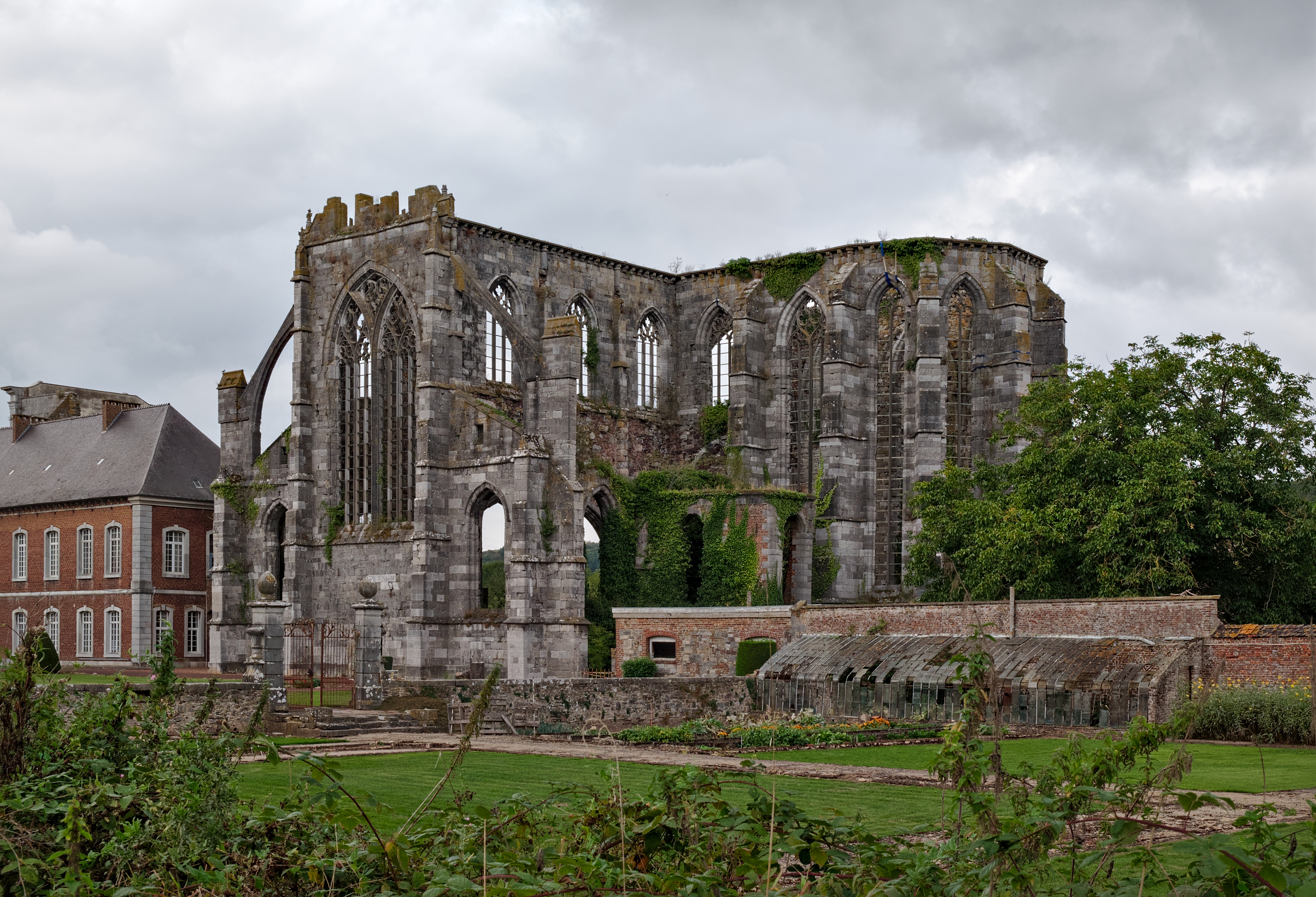Aulne Abbey on:
[Wikipedia]
[Google]
[Amazon]
 Aulne Abbey was a
Aulne Abbey was a
Vol. 16 (Index). New York: The Encyclopedia Press, 1914 At the instance of Henry of Leyen,
 Aulne Abbey was a
Aulne Abbey was a Cistercian
The Cistercians, () officially the Order of Cistercians ( la, (Sacer) Ordo Cisterciensis, abbreviated as OCist or SOCist), are a Catholic religious order of monks and nuns that branched off from the Benedictines and follow the Rule of Saint ...
monastery located in Wallonia
Wallonia (; french: Wallonie ), or ; nl, Wallonië ; wa, Waloneye or officially the Walloon Region (french: link=no, Région wallonne),; nl, link=no, Waals gewest; wa, link=no, Redjon walone is one of the three regions of Belgium—alo ...
between Thuin
Thuin ( or ; wa, Twin) is a city and municipality of Wallonia located in the province of Hainaut, Belgium.
The municipality consists of the following districts: Biercée, Biesme-sous-Thuin, Donstiennes, Gozée, Leers-et-Fosteau, Ragnies, ...
and Landelies on the Sambre
The Sambre (; nl, Samber, ) is a river in northern France and in Wallonia, Belgium. It is a left-bank tributary of the Meuse, which it joins in the Wallonian capital Namur.
The source of the Sambre is near Le Nouvion-en-Thiérache, in the Aisne ...
in the Bishopric of Liège in Belgium
Belgium, ; french: Belgique ; german: Belgien officially the Kingdom of Belgium, is a country in Northwestern Europe. The country is bordered by the Netherlands to the north, Germany to the east, Luxembourg to the southeast, France to th ...
, now a Walloon Heritage Site.
History
It was originally founded as aBenedictine
, image = Medalla San Benito.PNG
, caption = Design on the obverse side of the Saint Benedict Medal
, abbreviation = OSB
, formation =
, motto = (English: 'Pray and Work')
, foun ...
monastery in 656 on the banks of the Sambre in the ''"Vallée de la Paix'' (Valley of peace in the Walloon region of Belgium by Landelinus
Saint Landelin (Dutch language, Dutch and la, Landelinus; french: La(u)ndelin; 625 – 686 AD in what is now Belgium) is a saint in the Eastern Orthodox Church and Roman Catholic Church.
Life
Landelin was born to a noble family at Vaux near B ...
, abbot of Crespin Abbey
Crespin Abbey (french: Abbaye de Crespin) was a Benedictine monastery in the commune of Crespin in the department of Nord, France, founded around 648 by the reformed brigand Landelin of Crespin, also the first abbot, and dissolved in 1802.
Fo ...
. Sometime before 974 the Benedictines were replaced by secular clerics leading a common life, who, in 1144 adopted the Rule of St. Augustine.Ott, Michael. "Aulne Abbey." The Catholic EncyclopediaVol. 16 (Index). New York: The Encyclopedia Press, 1914 At the instance of Henry of Leyen,
Bishop of Liège
A bishop is an ordained clergy member who is entrusted with a position of authority and oversight in a religious institution.
In Christianity, bishops are normally responsible for the governance of dioceses. The role or office of bishop is ...
, it came into the hands of Cistercian monks from Clairvaux in 1147, under Franco de Morvaux as its first Cistercian abbot. From that time onwards it flourished as a Cistercian monastery. The monks constructed an extensive irrigation system and six ponds that provided fish for the abbey. Building commenced on the abbey church in 1214 by Father Gilles de Beaumont.
French revolutionary troops burned the abbey in 1794, only a short time after it had been rebuilt on a larger scale. The library, which contained 40,000 books and 5,000 manuscripts, was also destroyed. In 1859 the last monk died; the Monastery was abandoned and the abbot's residence turned into a hospice.
Blessed Simon of Aulne
The son of a Belgian nobleman descended from the counts of Guelders, at the age of sixteen, Simon joined the Cistercians at Aulne as a lay-brother. He was assigned to work in the monastery granaries and tend the sheep. Simon was a mystic who experienced visions and was believed to have the gift of reading hearts. His reputation spread and in 1215 he was summoned to Rome byPope Innocent III
Pope Innocent III ( la, Innocentius III; 1160 or 1161 – 16 July 1216), born Lotario dei Conti di Segni (anglicized as Lothar of Segni), was the head of the Catholic Church and ruler of the Papal States from 8 January 1198 to his death in 16 J ...
to advise the Pope during the Fourth Lateran Council
The Fourth Council of the Lateran or Lateran IV was convoked by Pope Innocent III in April 1213 and opened at the Lateran Palace in Rome on 11 November 1215. Due to the great length of time between the Council's convocation and meeting, many bi ...
. After the council, the pope wished to ordain Simon to the priesthood, but he declined and returned to Aulne. He died at the age of eighty-four on November 6, 1228. Never formally canonized he has been venerated for centuries and is commemorated on November 6.
Present day
In 2006, the abbey was acquired by the Region of Wallonia as an historic monument. There is an onsite cafe for the convenience of visitors and an interpretive centre. An on-site brewery was revived in 1950.References
Sources
* Endnotes: ** ** ** {{Coord, 50, 23, N, 4, 20, E, display=title, region:BE_type:landmark_source:dewiki Ruined Christian monasteries in Belgium Christian monasteries in Hainaut (province) Wallonia's Major Heritage Canons regular Augustinian monasteries in Belgium Cistercian monasteries in Belgium Benedictine monasteries in Belgium 7th-century establishments in Francia 18th-century disestablishments in the Southern Netherlands Christian monasteries established in the 7th century Monasteries destroyed during the French Revolution Thuin 630s establishments Christian monasteries disestablished in the 18th century 7th-century churches in Belgium